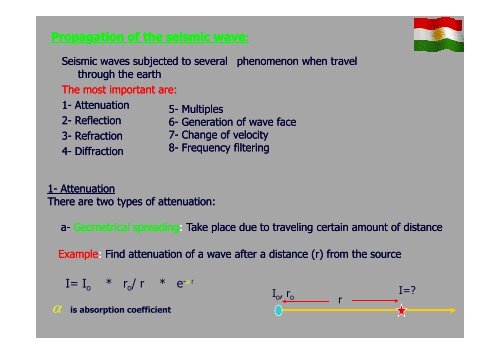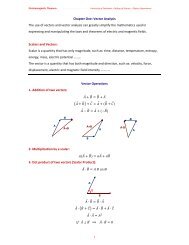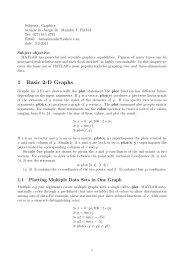Propagation of the seismic wave Propagation of the seismic wave
Propagation of the seismic wave Propagation of the seismic wave
Propagation of the seismic wave Propagation of the seismic wave
You also want an ePaper? Increase the reach of your titles
YUMPU automatically turns print PDFs into web optimized ePapers that Google loves.
<strong>Propagation</strong> <strong>of</strong> <strong>the</strong> <strong>seismic</strong> <strong>wave</strong>:<br />
Seismic <strong>wave</strong>s subjected to several phenomenon when travel<br />
through <strong>the</strong> earth<br />
The most important are:<br />
1- Attenuation<br />
2- Reflection<br />
3- Refraction<br />
4- Diffraction<br />
5- Multiples<br />
6- Generation <strong>of</strong> <strong>wave</strong> face<br />
7- Change <strong>of</strong> velocity<br />
8- Frequency filtering<br />
1- Attenuation<br />
There are two types <strong>of</strong> attenuation:<br />
a- Geometrical spreading: Take place due to traveling certain amount <strong>of</strong> distance<br />
Example: Find attenuation <strong>of</strong> a <strong>wave</strong> after a distance (r) from <strong>the</strong> source<br />
α<br />
I= I o * r o / r * e - α r<br />
is absorption coefficient<br />
I o , r o<br />
r<br />
I=?
- Intrinsic attenuation: loss <strong>of</strong> amplitude taken place due to dissipation <strong>of</strong><br />
energy into heat by friction<br />
Io<br />
e -œr<br />
Distance<br />
Note:<br />
Higher frequencies attenuate over shorter distances due to <strong>the</strong>ir shorter <strong>wave</strong>lengths.<br />
Therefore, high frequencies decay first leaving a low frequency signal remaining.<br />
2- Reflection:<br />
It is take place when a <strong>seismic</strong> <strong>wave</strong> hits an interface separating two media <strong>of</strong><br />
different elastic Properties (or different acoustic impedance, z)<br />
Acoustic impedance: define as <strong>the</strong> product <strong>of</strong> velocity with density<br />
Z = p * V
Z1 = p 1 * V1<br />
Z2 = p 2 * V2
Reflection Coefficient: It is a ratio <strong>of</strong> reflected <strong>wave</strong> amplitude (Ar) to<br />
incidence <strong>wave</strong> amplitude (Ai)<br />
R = Ar / Ai = Z2 – Z1 / Z2 + Z1 = P2V2 – P1V1 / P2V2 + P1V1<br />
Notes:<br />
1- R is positive when Z2>Z1 and negative when Z1>Z2<br />
2- R =+1 when Z1 = 0 and R = -1 when Z2 = 0<br />
3- R is approach to unity in two cases:<br />
a- When incidence angle = Critical incidence angle<br />
b- Tangential (Grazing) incidence<br />
(a)<br />
(b)
3- Refraction : Apart <strong>of</strong> <strong>seismic</strong> <strong>wave</strong> is refracted when hits an interface<br />
separating two media<br />
Refraction depend on Snell’s law:<br />
Notes:<br />
1- When V 2 is smaller than V 1 so i 1 > i 2 , in this case<br />
refraction will not take place, <strong>the</strong> <strong>wave</strong> will be<br />
deflected.<br />
2- When V 2 >V 1 , i 2 will be greater than i 1 , when i 2 =90<br />
<strong>the</strong><br />
<strong>wave</strong> will travel along <strong>the</strong> interface and refraction will<br />
take place,<br />
So i 2 is called critical angle.<br />
i1<br />
Refraction not take place<br />
Refraction not take place<br />
Refraction will take place and i 1 is called<br />
critical angle =i c , i 2 = 90, <strong>the</strong>n sin 90 =1<br />
i2<br />
So Sin i c = V1 / V2
4- Diffraction:<br />
it takes place when <strong>the</strong> <strong>seismic</strong> <strong>wave</strong> hits:<br />
1- Irregularity<br />
2- Abrupt discontinuity<br />
3- Faults<br />
In this case <strong>the</strong> irregular feature act as point source for radiating <strong>wave</strong>s in all<br />
directions.<br />
Source<br />
Surface<br />
V1<br />
V2<br />
Faults<br />
5- Multiple:<br />
They are signals undergone more than one reflection, and <strong>the</strong>y are <strong>of</strong><br />
small energy<br />
There are two types <strong>of</strong> multiples:<br />
1-Short path multiples : They are almost arrived with useful signals and form a tail to<br />
<strong>the</strong>m, such as<br />
A- Ghost<br />
B- Near-surface multiples<br />
C- Peg-leg Multiples
2- Long path Multiples : They are arrived at a later time than primary<br />
Such as<br />
A- Simple multiples.<br />
reflections, <strong>the</strong>y appear as a separate signals.<br />
B- Interformational multiples.<br />
Primary<br />
Reflection Ghost<br />
Near<br />
Surface<br />
Peg-Leg<br />
Simple<br />
Multiple<br />
Surface<br />
Interformational<br />
Short path Multiples<br />
Long path Multiples
6- Generation <strong>of</strong> <strong>wave</strong> phase:<br />
When P-<strong>wave</strong> hits an interface generate four types <strong>of</strong> <strong>the</strong> <strong>seismic</strong> <strong>wave</strong>s:<br />
Seismic Wave<br />
Reflected S-Wave<br />
Reflected P-Wave<br />
Refracted P-Wave<br />
Refracted S-Wave<br />
Notes:<br />
1- When <strong>the</strong> <strong>wave</strong> hits an interface vertically , does not generate o<strong>the</strong>r type <strong>of</strong> <strong>wave</strong>s.<br />
2- When <strong>the</strong> first medium is liquid, only three types will generate because S-<strong>wave</strong> does<br />
not propagates through <strong>the</strong> liquid.

















